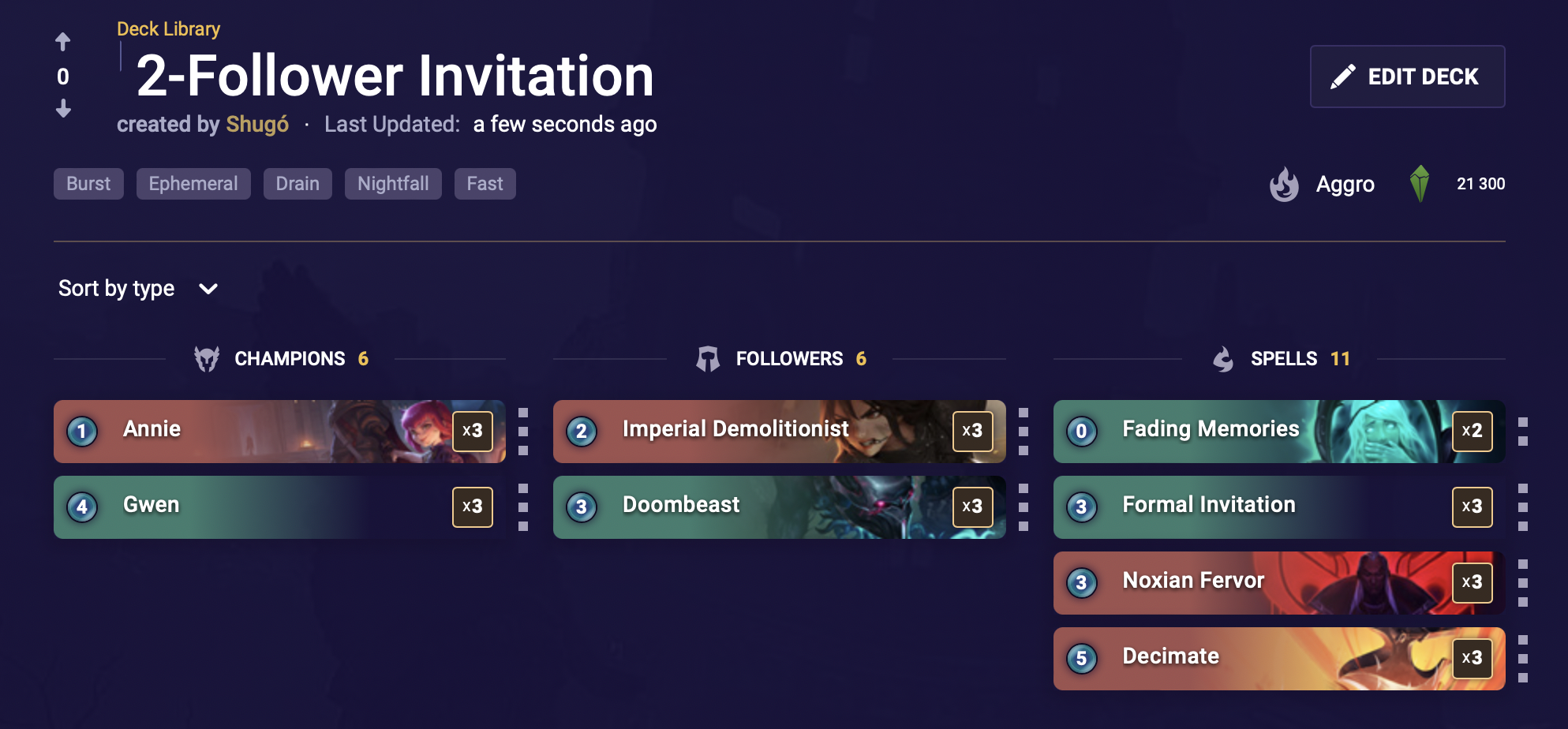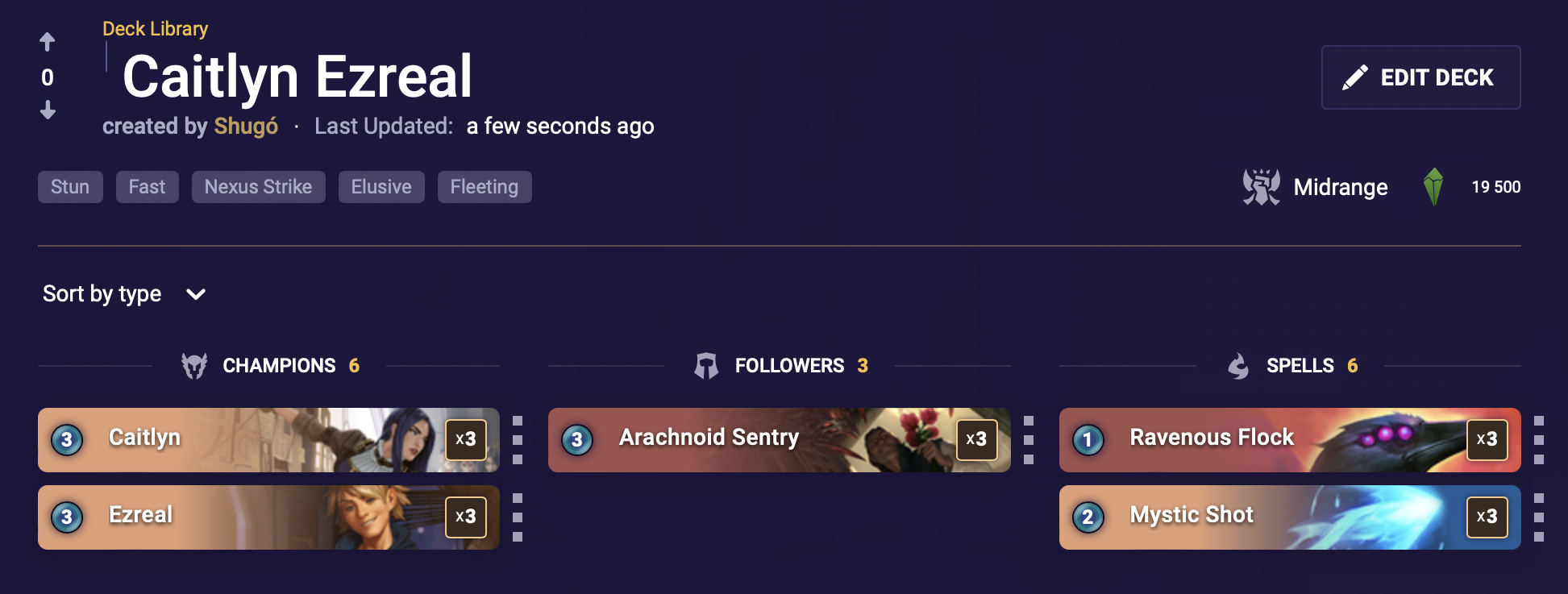How to Build a Legends of Runeterra Deck
It’s that time again. The moment we’ve all been waiting for… new cards! To all of us deck builders out there, it feels like Christmas morning. The metagame has been refreshed and it’s time to brew. The possibilities are endless!
But where do we begin?
Building an effective deck is not easy, even for experienced players. There’s a lot of testing, tuning, and going back to the drawing board. Even when it’s all said and done, there’s a good chance we didn’t create the perfect deck we were hoping for. And that’s okay!
It’s Trevor “Shugo” Yung here and today I’m going to go over my approach to deckbuilding!
Choose a Concept
Every deck begins with an idea. In LoR, the most common place to start is with the champions. They are undeniably powerful, and with champions being the only limited card type (max 6 per deck), it makes sense to build around them. This is a given already, so let’s look at two other ways we can discover a concept.
Specific Card Interactions
Sometimes it all starts with a unique interaction between a couple of cards. Let’s look at an example using one of the new cards, Formal Invitation, and pair it with Doombeast.
Formal Invitation creates copies of two allied followers that have died during the game. In the average use case, this will create two random followers. But what if we could guarantee ourselves a Doombeast? That’s a lot of burn!
So how could we accomplish this? Build a deck with only two different followers. That may sound kinda crazy, but having this drawback does come with a pretty intriguing payoff. Plus, we’ll still have our champions.
As for the second follower, Boomcrew Rookie or Imperial Demolitionist would be great options to consider as they both compliment our game plan.

While this is likely miles away from being competitive, it’s an example of how we can take a couple of non-champion cards and theory craft a whole new type of list.
It’s possible as we start filling out the rest of the deck that we add Ravenbloom Conservatory, bumping up to three followers we’re happy to create with Formal Invitation. Or perhaps we scrap the Noxus half in favor of Jhin, then bring in the Boomcrew Rookies!
I’ll leave the rest up to your imagination. 😉
Anti-Meta Approach
There are times when the meta stabilizes to a pretty consistent degree. The top dogs are known, and the decks that exist on ladder are common appearances. If you can identify the pocket-meta you’re in, perhaps there’s a way to build to counter it.
This type of deckbuilding comes with its own flaws. For starters, not every metagame is narrow enough that you can appropriately build against it. And even when it is, there’s a good chance matchmaking doesn’t line up that way you hoped.
Overall, it’s better to build with your own game plan in mind, rather than your opponent’s. But if you can find a way to effectively tie the two together, it could be a good starting point!
Identify Strengths
Once you’ve chosen a concept, it’s important to identify the pillar cards to your strategy. These should be the most powerful options; the staples of the archetype or region.
For example, let’s say we’re looking to rebuild Caitlyn Ezreal. The immediate cards that come to mind are Mystic Shot and Ravenous Flock. These are two key cards that define the archetype and confirm the region pairing of Noxus PnZ. From there, the next obvious inclusion is Arachnoid Sentry.

It’s good to keep this in mind when starting out. If you aren’t playing the staples from your regions, then what is the reason for including them? Would another region be able to support your strategy better?
Sometimes we pigeonhole ourselves into certain champion pairings when in reality, we’re much better off forgoing the lesser champion and picking a better second region. Take the time to consider multiple regions and compare the best cards that each one has to offer.
You’ll usually be able to narrow down on 1-2 regions that have a considerable advantage above the rest. Then you can put together a shell for each and go from there!
Assemble a Shell
Once we’ve defined the pillars of our strategy, it’s time to build out the core of our deck. These are the bread and butter cards that make everything churn nicely. If you ever struggle to find enough cards for the outline, it’s probably an early sign that the concept won’t work. We should have a good amount of structure before looking to fill in the gaps.
Let’s have a look at a rough shell for Soraka Tahm Kench.

All of these cards are just about staple 3-of’s in every Star Spring list. This makes up 27/40 cards and still leaves room for many other inclusions.
Star Shepherd and Broadback Protector can often be found in many versions, along with Shakedown for additional interaction. Though these are not always selected, and thus aren’t included in the original shell.
Defining a shell can be important as it gives the deck direction. Each inclusion is vital to the strategy. When proceeding to fill in the rest of the gaps, ask yourself, does this support my game plan? In what way does this card serve me?
As fun as it can be to just jam any odd card into the list, you’ll save a lot of time if you take a moment to really consider it first. But if you really want to, give it a try! You can always cut it later.
Include Interaction
In a fresh metagame, it’s better to be more proactive than reactive. When decks are unrefined, they’ll even lose to themselves, so don’t worry about including too many tech cards. After all, it’s hard to have the answer when you don’t even know the question.
Once things stabilize, that’s the time you’ll really want to be cognizant of the meta.
Ask yourself: What popular decks do I need to account for? How does my deck fare in those matchups?
Another important question. Does my interaction support or detract from my game plan? Some decks aren’t accustomed to playing much removal, and really can’t afford the slot. Simply adding a tech card may not even win you the matchup. You could have better odds just playing for a solid curve, compared to playing out a mediocre draw with the tech card in hand.
It can be hard to find the right balance and amount of interaction, and that’s where the playtesting comes in. As you get more games in, you’ll learn what cards are worth their slot.
Reflect & Revise
After we’ve had the chance to play a few games, we’ll likely already have a pretty good idea of how the deck feels. Of course, while it’s hard to judge perfectly with a small sample size, we’ll be able to evaluate some of the play patterns.
Then we can reflect and ask ourselves more questions.
- What does this deck do well?
- What are its weaknesses?
- How reliable is my win condition?
- Does another deck do a similar thing, but better?
The last one is often a truth that’s hardest to accept. While we may have created a functional deck that can hold its own if it’s a worse version of something that already exists, why are we playing it?
Don’t be afraid to let go and move on. There’s always time to revisit it later, and you may discover something even greater next time!
There’s no right or wrong way to approach deckbuilding, but I hope this helps inspire some direction to those who may struggle with where to begin. Until next time, happy brewing!
Shugo’s Productivity Thought of the Day
Allow yourself the permission to mess up.
One perfect day doesn’t define you, and neither does one mistake.
It’s not about how often you fail, but about how often you get back up to try again.
Ready to build a new deck with these tips? Head to the Deck Builder!
Subscribe to our newsletter:
Don’t miss out on all of the latest LoR content!
 Download APP
Download APP